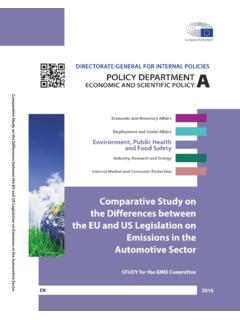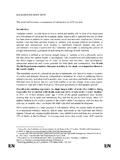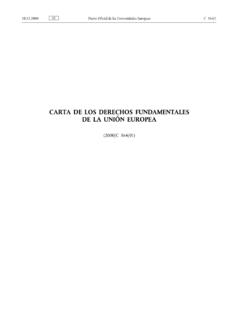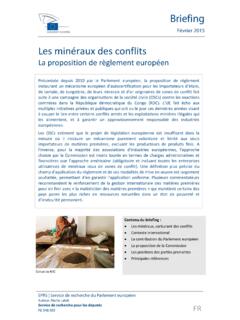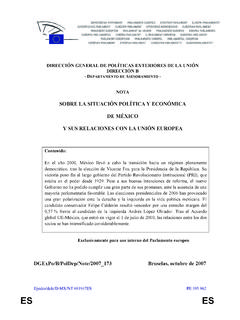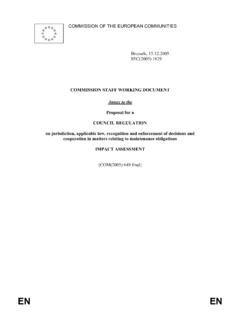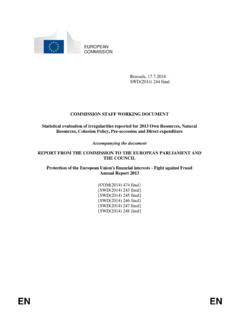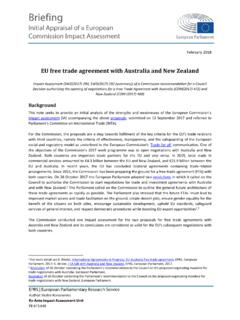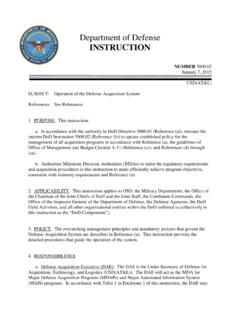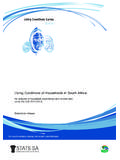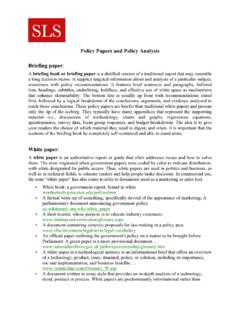Transcription of Consumer protection in the EU - European Parliament
1 IN-DEPTH ANALYSISEPRS | European Parliamentary Research ServiceAuthor:Jana ValantMembers' Research ServiceSeptember2015 intheEUPolicy overviewThisdocumentseeksto provide an overview of Consumer protection policy, focusing on the generalprinciples(competences of the European Union,legal baseand definitionof the notion of Consumer ).Itexaminesthe tools available toensure the protection ofconsumersin the legally bindingtools consist of around 90 directives and a few regulations. Othersupplementarytools to monitor andimprove theprotection of consumers within the EU marketincludeconsumer scoreboards, marketstudies and behavioural studies commissioned by the European Commission, awareness-raising andinformation campaigns within the European Consumer Centres networkand the work oftheEuropeanJudicial aim of thedocumentistopresentkey EU policy areas related to consumerprotection,tohighlightpast improvements and success stories,andtoidentifyshortcomingsandfutu re policy 978-92-823-7554-9doi: manuscript, inEnglish,completed content of this document is the sole responsibility of the author and any opinionsexpressed therein do not necessarily represent the official position of the European is addressed to the Members and staff of the EP for their parliamentary work.
2 Reproductionand translation for non-commercial purposes are authorised, provided the sourceisacknowledged and the European Parliament is given prior notice and sent a copy. European Union, credits: protection in the EUPage1of21 EXECUTIVE SUMMARYT hefinal consumption expenditure of householdscurrentlyaccounts for 57% of EUgross domestic market that serves consumers wellisthereforeanimportant element tostimulatingEurope'seconomic Resolution of 14 April 1975on a preliminary programme of the EuropeanEconomic Communityfor a Consumer protection and information policy constituted theformal inauguration of Consumer protection policyat EU time, Consumer policyhas become one of the mosttransversalEUpolicies, covering product safety, digitalmarket, financialservices, foodsafetyand labelling, energy, travel and years it has shifted from the technical harmonisation of standards to therecognition of Consumer protection as part of the effort to establish a 'Europe forcitizens'.
3 Currently, the programme of EU action in the field of Consumer policyis based on twomeasures: theEuropean Consumer Agenda,which is the new strategy for EU consumerpolicy in line with the EU's growth strategy Europe 2020 and theconsumerprogramme 2014-20 the financial framework complementing the strategy. Theconsumer agendahasfour mainobjectives:improving Consumer safety;enhancingknowledge;improving implementation, stepping up enforcement and securingredressas well asaligning rights and key policies to economic and societal ,the question of potentially changing the current instrument ofharmonisationatEU level the directive are somesuccess stories, such assignificantlowering of roaming chargesin recentyears,openconsumer protectionrelatedissuesstillexist, for examplein relation todata protection ,as well asregardingthe negotiations onaTransatlantic Trade and InvestmentPartnership (TTIP)with theUnited addition,a number offuture challengesremain, such asdefiningtheevolving conceptofprosumersandprotecting consumers fromthenew practices ofcollaborative economyas well as adaptingthe policytotechnological protection in the EUPage2of21 TABLE OF CONTENTS1.
4 General Legal The notion of Tools protecting the EU Tools to assess, monitor and improve the protection of Market monitoring Awareness-raising Tools for stepping up enforcement and securing Key EU policy areas related to Consumer Product Digital Financial Food safety and Travel, leisure and Past improvements of Consumer protection in the EU and its Success Weak The challenges of behavioural Policy Consumer protection and European Commission Future challenges of the collaborative The concept of 'prosumers'.. European Consumer protection concerns regarding Transatlantic Trade and Investmentpartnership (TTIP)..205. Further protection in the principlesThe aim ofEuropean Consumer policyis to make the European Union(EU)a tangiblereality for 500million citizens by guaranteeing their rights as consumers. That meansprotecting consumers from serious risks and threats that they are unable to tackle asindividuals;empoweringthem to make choices based on accurate, clear and consistentinformation.
5 Enhancing their welfare and effectively protecting their safety as well astheir economic is to be achieved byaligning consumerrights and policiesto changes in society and legislation adoptedatEU levelaims primarilytoprotectthesafety, health, economicandlegal interestsof consumers,as well asofferingredressandgeneral product safety to the Treaty on the Functioning of the European Union(TFEU),consumerprotectionissues are a shared competence of the EU and Member EUlegislation in this domain is adopted through the ordinary legislative procedure, theMemberStates areresponsible forimplementing andenforcing the EU , the final consumption expenditure of households accounts for 57% of EUgross domestic Consumer policy strategy for the period 2014-20 is definedintheEuropeanConsumerAgenda,2whic h is complemented,in itsfinancial aspects, bytheConsumer Consumer programme(2014-20)foresees a budget of (corresponding to around Consumer per year).
6 BasisArticles 4(2)(f), 12, 114(3) and 169 of TFEU and Article 38 of the Charter ofFundamental Rights of the European Union constitutetheprimary lawforconsumerprotection policy. Article 169 TFEU definesspecific objectives of the policy:In order to promote the interests of consumers and to ensure a high level of consumerprotection, the Union shall contribute to protecting thehealth, safety and economicinterestsof consumers, as well as to promoting theirright to information, educationand to organise themselves in order to safeguard their 169supplementsArticle 114of theTFEU, which indicatesthat in its proposalsconcerning health, safety, environmental protection and Consumer protection theCommission will take asabase a high level of theTFEU alsostates that EU measures shall not prevent any Member State from maintaining orintroducing more stringent protective measuresprovided thatthey are compatiblewith the this wayEU law providesa common basiclevel of protection to allconsumers residing in the.
7 Article 12 TFEU clarifies that consumerprotection requirements must be taken into account in defining and implementingother Union policies and activities, while Article 38 of the Charter of Fundamental1 Consumer Markets Scoreboard:Making markets work for consumers,10th edition, EuropeanCommission, 2014,SWD(2014)212 European Consumer Agenda-Boosting confidence and growth,COM(2012)225 (EU) No 254/2014 on a multiannual Consumer programme for the years 2014-20 andrepealing Decision No 1926/2006 protection in the EUPage4of21 Rights of the European Unionconfirms the importance ofconsumer protection ,statingthat Union policies shall ensure a high level of Consumer notion of consumerThereisno consistent and uniform definitionofconsumerin EU lawandthere are alsodivergences amongst the Member States,partlyas a result of transposing EU directivesinto national legislation. Inthecurrent EU consumeracquiseach EU instrument definesthe notion of consumerseparatelyfor its own definitions essentiallyconverge,butsome notion of Consumer has been defined inseveral directives in the area of contract law,as well as in the regulation BrusselsI5andRomeI6(in the area of procedural law), which include specific rules for majority of current EU directives define the Consumer as a'naturalperson who is acting for the purposes which are outside his trade, business andprofession'.
8 The definition is therefore a negative directivesalsodiverge inthedefinition of economic activity, some also includinga'craft'.The notion ofconsumer in EU lawdoes notapplyto legal persons, even if they have a non-businesscharacter, as would be the case for non-profit has also beenemphasised inthecase law oftheCourt of Justiceon several ,namelythe Package Travel Directive90/314/EEC,whichuses abroadernotion of the Consumer by including companies and business travellers as purchasersand users of travel of theminimumharmonisation character of thelargerpartof the consumeracquis, many Member Statesextendedthe scope of their Consumer protection lawbeyond the definition of ' Consumer ' in EU protecting the LegislationTheCounciladoptedits first special programme for Consumer protection andinformation policy in1975,9where itdefinedfive fundamental Consumer rights: theright to protection of health and safety, the right to protection of economic interests,the right to claim for damages, the right to an education, and the right to legalrepresentation (or theright otherwise to be heard).
9 This programme(together withitssuccessors)hasserved as a basis for anevergrowing corpus of directives andregulations in the area of Consumer right to Consumer protection enshrined in Article 38 of the Charter of Fundamental Rights doesnot grant a substantive right to European citizens, but rather refers to the EU s objective of ensuring ahigh level of Consumer protection . See : The Constitutional Approach to Basic ConsumerRights, 2012, (EC) No 44/2001 on jurisdiction and the recognition and enforcement of judgments in civiland commercial matters,layingdown rules governing the jurisdiction of courts and the recognitionand enforcement of judgments in civil and commercial matters in EU (EC) No 593/2008 on the law applicable to contractual obligations,applyingto contractualobligations in civil and commercial matters in the event of a conflict of TravelDirective is currently instance:F. Price Indication Directive (98/6), lke and orThe notion of ' Consumer ' in EU law, ko, EPRS, Resolution on a preliminary programme of the European Economic Community for aconsumer protection and information policy,OJ C-092, protection in the EUPage5of21In line with the principles of subsidiarity and proportionality,the European Union'sintervention must be qualified as necessary in order to provide adequate andequivalent levels of Consumer particular legal instrumentpredominantlyused by the EU in field of Consumer protection has been the not apply directly and it needs to be transposed into the national laws of each EUMember EU therefore introduced a common set of Consumer protectionrules by requiring each national law to be adjusted, rather than by adopting regulationswhich would apply directly without the need forfurther action by the Member , butsomewhatexceptionallyin thisfield.
10 Thedirectly applicableinstrument theregulation was present, around 90 EUdirectives coverconsumerprotection issues,andthat is whythe consumeracquisremains complex and sometimes inconsistent (in the case ofthesame directive, since it can be transposed into national law differently,butalsobecause ofdifferencesbetween various directives).Thegreater partof EU consumerlaw remains ofa minimumharmonisation a result,the corresponding nationallegislation(either pre-existing or adoptedlaterto transpose a directive) can go evenfurther than therelevant practice,thismeansthat traders and consumersalike still need to beveryaware of the relevant national legislation (in particular,regarding matters left to national law).If a dispute arises, consumerscannot invoke the directive against a trader directly,it isup to the national courts toapply and interpret these rules10and theycanrequestadditional interpretation from the European Court of Justicethroughthe preliminaryruling ,this isratherinfrequent,which can also contribute topotential divergences in the interpretation of particular provisions based on an toassess,monitor and improve the protection of consumersLegally non-bindingtools aimed at improving, monitoring and assessing the currentstate andenforcement of Consumer protection available on the EU level are:marketmonitoring tools,tools forawareness-raising(providing information to consumersabouttheirrights) andtools for stepping up enforcementand securing theJudgment of the Court of Justice of 14 July 1994(Paola Faccini Doriv Recreb Srl.)
